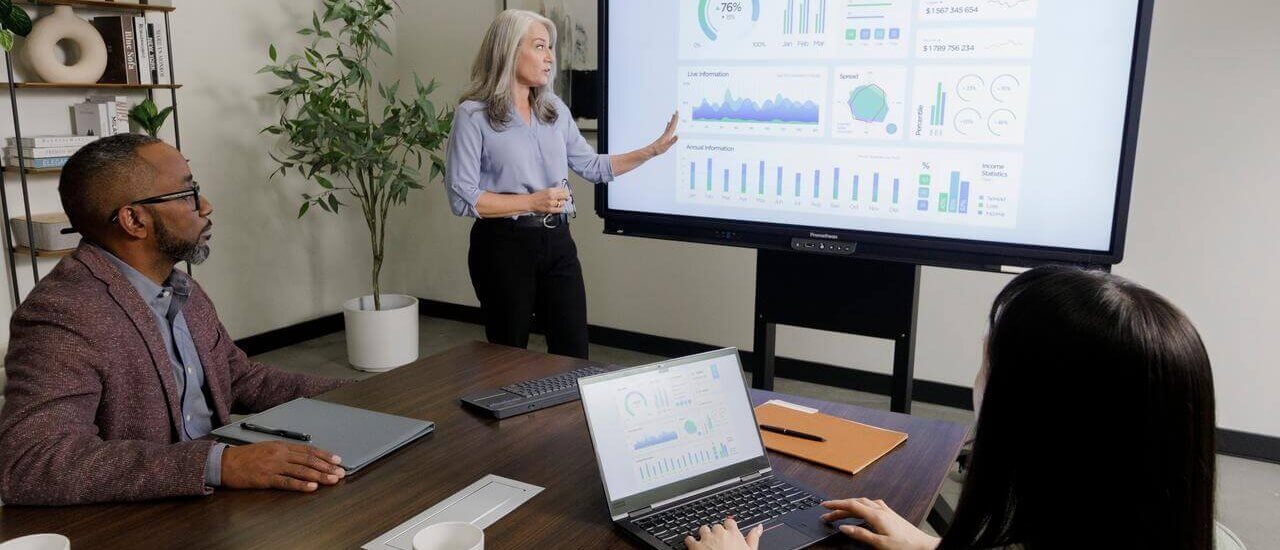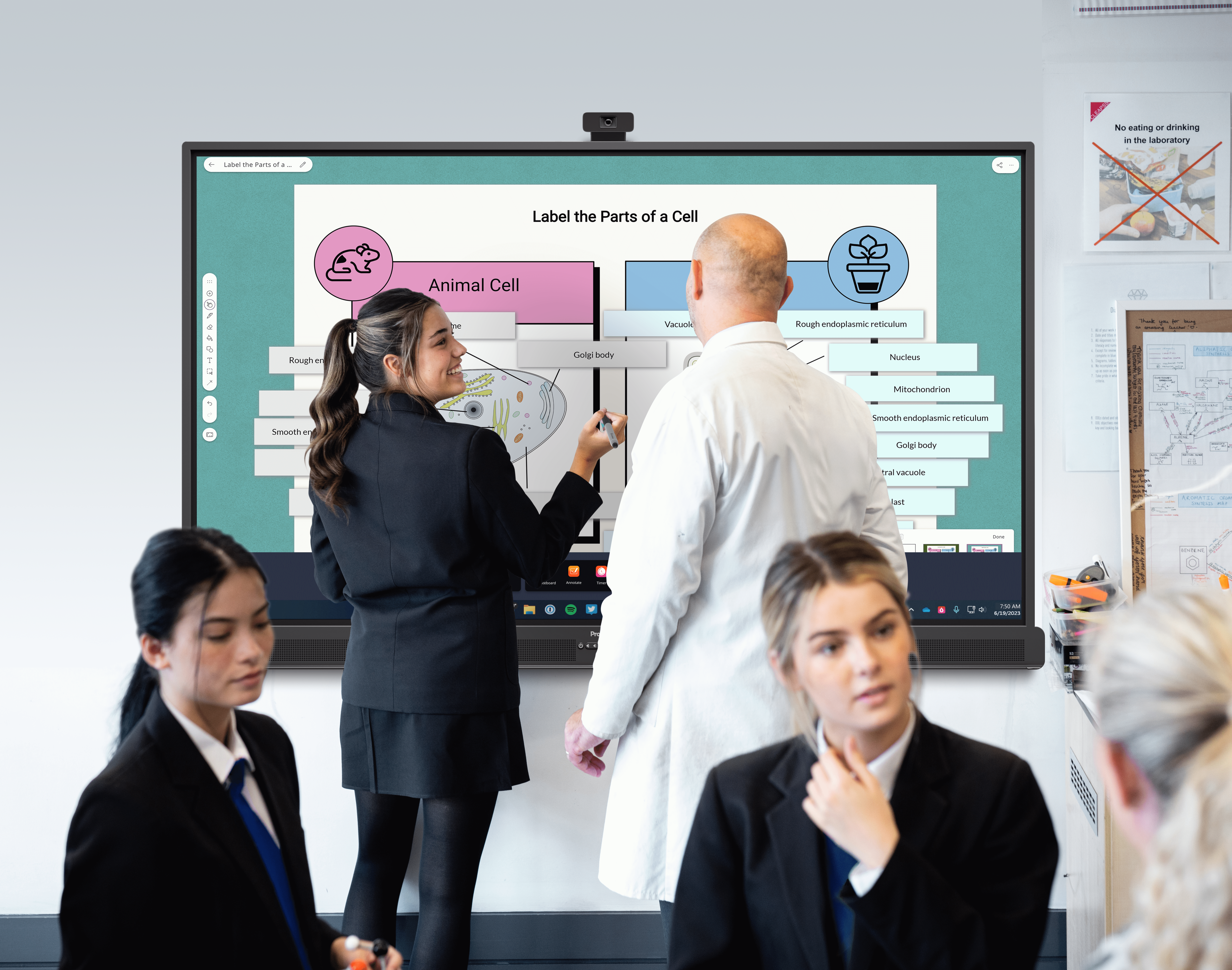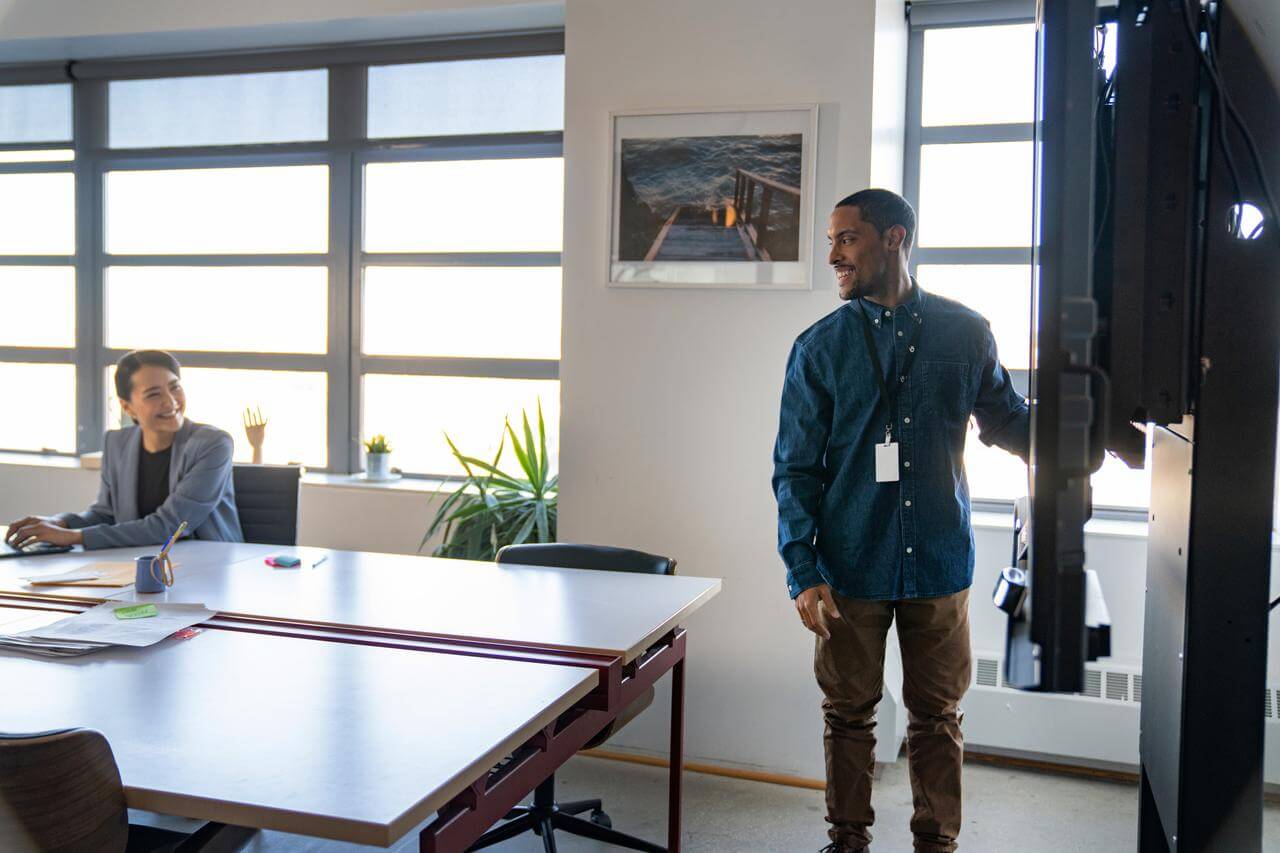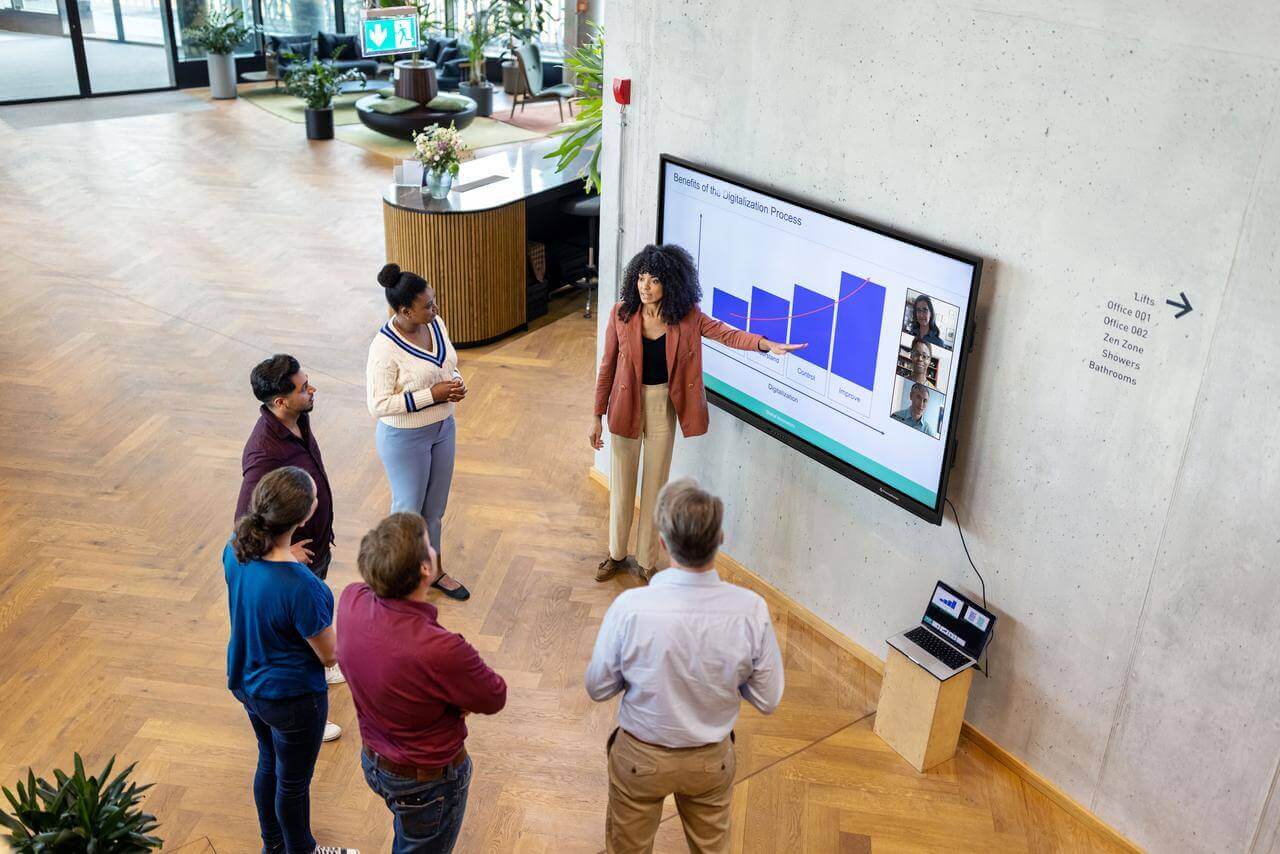Published on December 10th, 2024
Conference Room Setup: How to Optimise Your Space to Get the Most out of Your Meetings
13 minute read

Summary
As the world of hybrid working becomes ever more prevalent, office managers are tasked with finding increasingly more efficient ways to optimise shared workspaces. Hot desking is becoming more commonplace for teams who spend only a portion of their week in the office, while one-time meeting rooms are now conference rooms, equipped with audiovisual technology to allow office workers to collaborate with their remote colleagues.
According to the International Convention Centre Belfast, getting your conference room setup right plays a pivotal role in allowing it to be used in an efficient and productive manner. They suggest that a thoughtfully designed conference room “encourages engagement among attendees by facilitating clear communication through audiovisual tools and comfortable seating arrangements, making it more likely for everyone to actively participate”.
In this article, we’ll explore how to optimise your space for its intended use, and how the conference room technology with which you equip it can make a substantial difference to its efficacy.
Hybrid Meeting Room Setup
If you have a clean slate from which to start, before jumping into the details of your hybrid meeting room setup and design, you may wish to spend some time considering where you’ll host your meeting room.
Many businesses are investing in increasingly smaller conference rooms, which generally means they can choose from a wider range of locations within their office space. The New York Times reports an increase in the prevalence of outdoor meeting spaces, owing to research demonstrating the positive impact that exposure to nature can have on creativity and reduced stress levels. Elsewhere, the creative industries have seen success from installing conferencing ‘booths’ in open-plan offices for more informal or ad-hoc meetings.
Layout and Furniture
Once you’ve established where you’re going to locate your space, you can start thinking about your conference room setup, and it’s worth considering what you intend to use it for. If you plan to host large in-person conferences, then a cabaret-style layout encourages group discussion and collaboration. For smaller meetings, a round table or U-shaped formation provides an intimate setting and insinuates an equal standing that encourages free-form conversations. Panel discussions, on the other hand, are best suited to either a classroom- or a theatre-style layout.
If you’re planning to use your conference room as a video-conferencing space, then you’ll need to consider the camera’s field of vision, especially with regard to your conference table size and shape. It can be worth investing in meeting tables with one end wider than the other so that the camera can see everyone. If you’re using a boardroom-style layout, make sure the camera is positioned at one of the shorter ends of the table so that it doesn’t crop participants out.
Your seating should be comfortable and adjustable. Multiple studies have shown that physical comfort in the workplace inspires productivity; while those bean bags might not be appropriate for formal client meetings, they are a great addition to creative spaces. Swivel chairs, on the other hand, are ideal for rooms equipped with video conferencing as they allow attendees to easily switch their attention between remote participants and those in the room.
It’s also important to ensure that your furniture is light so that it can be rearranged for a variety of functions. You may even wish to invest in moveable partitions so that you can alter your conference room size so that it can be used equally as an intimate meeting room or a spacious networking environment.
What is the Ideal Conference Room Size?
The optimal size of your conference room will depend on its intended use, but market research specialists Frost & Sullivan observe that “video conferencing in large meeting spaces remains under-utilised and expensive”.
Elsewhere, it has been noted that the most productive meetings contain between five and eight people, so it may be more practicable to have multiple, smaller meeting spaces than fewer large ones. If your business has a regular need for larger information-sharing or networking sessions, then you may wish to consider either a separate space for this purpose or an adaptable, multifunctional space.
Conference Room Technology
A staple of any conference room technology setup is an audiovisual system. Not only does this allow you to deliver engaging presentations or supplement your meetings with visual and aural resources, but it also allows your in-person and remote participants to communicate together in real time. Screen Sharing technologies can provide remote colleagues with access to the same resources that your in-person attendees have. If you get your meeting room tech right, you can offer your remote participants an experience that rivals being in the room.
Interactive Displays
The most common audiovisual setup for small- to medium-sized conference rooms is an interactive display. Interactive displays are an all-in-one solution that integrates visual information and two-way audio into one piece of equipment, many of which include touch-screen technology for enhanced, interactive presentations. This means that you don’t have to purchase too many extra components or worry about compatibility issues. Interactive displays can usually be mounted directly on the wall, but if you’re using the ActivPanel LX for Business, then you have the choice of mounting it on the wall or investing in an ActivPanel stand. Both are good options but a wheeled stand gives you the advantage of being able to move your interactive display around the room. This is ideal if you have a fluid, multifunctional space and gives you more control over your conference room setup and its function.
Relay Screens
If you have a particularly large conference room and are worried that audience members towards the back of the room may struggle to see your primary screen, you can use relay screens. Relay screens are secondary screens that display the content of your main screen so that everyone can see the detail, even in a large room. Typically they cannot be interacted with, but just relay the signal, giving you complete control over the content being displayed, and making your presentation accessible to everyone.
Conference Room Audio Systems
For very large rooms, it’s worth enlisting the help of an audio consultant, as they will be able to recommend the best conference room audio system for your space. If the primary intended use of your venue is for small meetings, then you will likely find that the built-in audio systems of an interactive display are sufficient for most applications. However, if you rely on a lot of audio information – such as videos or recordings – you should consider enhancing your audio setup with a soundbar. The plug-and-play ActivSoundBar can be mounted on top of any of the ActivPanels and offers up to 90 decibels of quality sound, which is ideal for noisier environments, medium- to large-sized conference rooms, or anything that requires high-quality audio.
Wireless Conference Room Microphones
Most interactive displays have built-in microphones, and these are usually sufficient for picking up sound in small- to medium-sized conference rooms, meaning you don’t have to invest in further hardware. However, if your conference room table is particularly long, you might consider placing additional microphones intermittently along the table or perhaps suspending them from the ceiling. There are plenty of wired and wireless variations available, and these can be connected to interactive displays. This is ideal if you have a very large conference room, and need to use a roaming wireless conference room microphone – these are particularly useful for large group discussions.
Webcams
The final piece of audiovisual kit you will need to consider is a webcam. This helps remote participants to understand who is speaking, to see any kinetic activity, and to feel more engaged in the discussion. Again, both wired and wireless options are available. When mounting your webcam, it’s optimal to do so on top of the interactive display. This way, if someone is presenting using an interactive display, participants’ focus will be directed toward the screen, meaning that in-person and remote participants will be looking toward each other, helping to provide a seamless experience and keeping everyone engaged. If you mount your webcam elsewhere in the room and remote participants can only see the backs of people’s heads, it’s much more difficult for them to participate in the conversation.
Conference Room Setup Tips
When it comes to setting up and equipping your conference room, the most important thing is to identify what it is you’re looking to achieve with your room. Productive, small team meetings will require a very different space to large, in-person conferences intended to accommodate unacquainted industry specialists. However, don’t forget that if you intend to use your space for a range of functions, you can consider how best to adopt a multifunctional space with temporary partitions and/or portable technology.
Once you have a clear understanding of what you intend to use your space for, use this checklist to make sure you don’t miss anything:
- Identify the best placement for your conference room
- Decide on an appropriate size for your room
- Choose an optimal layout depending on the function of the space
- Select appropriate furniture for your room
- Install an audiovisual setup considering:
- Interactive displays
- Conference room projectors
- Conference room audio systems
- Wireless conference room microphones
- Webcams
Contact Promethean for a free demo of the ActivPanel LX for Business and find out how it can be used to bring your meeting spaces to life and facilitate productive conversations.
Further reading:




